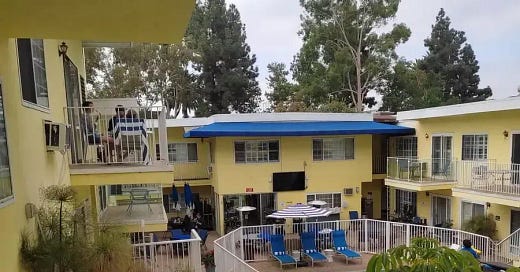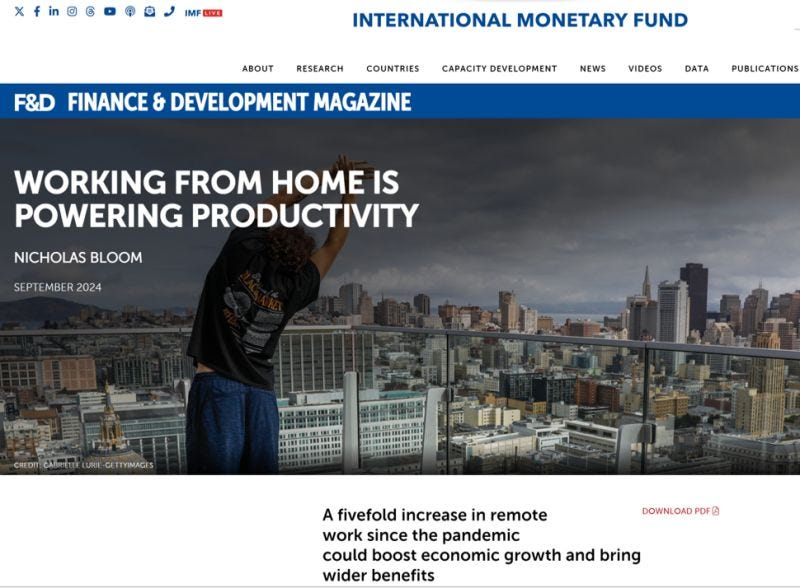Hello dear reader,
I hope you had a wonderful summer and managed to get some time for some rest and recuperation.
My family and I took a long-planned road-trip through California, the proverbial holiday of a lifetime. There were lots of personal highlights, but one bit in particular sent my professional strategy brain into frothy overdrive…
The best hotel in California.
During the second week of our road trip we landed in LA for a few days, and stayed at The Magic Castle Hotel. It was the most memorable hotel we’ve ever stayed in, and a masterclass in how to design a great customer experience.
The hotel is nothing to look at.
In fact, the dated interior looks like it could be the scene of a murder, or perhaps an exorcism, with air conditioning units shoved into the pale yellow walls by someone who hated their job and wanted everyone to know it. The furniture and finish in the rooms is very, very basic.
It’s also located in the most touristy part of Hollywood, just around the corner from the Hollywood walk of fame and Chinese Theatre, which is not a great part of LA. It’s like staying just off Times Square in NYC or Leicester Square in London. No local in their right mind would recommend staying here.
There is no restaurant. No room service. No elevator, despite being three stories high.
And yet…
The kids absolutely LOVED it and were begging us to stay longer. It was a highlight of our trip despite being up against Disney, Yosemite, Santa Monica and whale watching.
What gives?
Firstly, as the hotel is a converted apartment complex from the 30s, the rooms were bigger than your average hotel room, with a kitchen and dining table that made it feel like an apartment, and it also had a pool. So it’s great for families or groups that want a bit more space and somewhere to cool down after a day traipsing around LA in August.
Secondly, as well as being next to some Hollywood sights, it’s 15mins from Universal Studios, so despite it’s grotty surroundings, it’s super convenient for sightseers.
However, the location and room size just about makes up for the crime scene ambiance and dated interiors.
What really makes this an incredible place to stay is the level of customer care and the wonderful service features that show just how much they understand their customers, and what really matters to them.
The most memorable feature was the Popsicle hotline, a red phone (with a cord!) next to the pool for the sole purpose of ordering a popsicle (or ice-lolly for us Brits). It was always immediately answered by a member of staff, who proceeded to don white gloves and bring out a tray of frozen fruity treats. If you were in the pool the staff member even unwrapped the popsicle so that you could eat whilst chilling in the water.
Needless to say this feature alone BLEW THE CHILDREN’S MINDS!
In addition, there was an extensive list of snacks and treats that could be requested at the front desk any time. Not your usual hotel tat either. We’re talking Oreos, Reese’s, Cookies, Sour Patch etc. As well as a free ice-cream machine and drinks machine by the pool. And a free laundry service.
Lastly, the staff were incredible. They genuinely seemed to take pride in their work and enjoy putting a smile on guests faces.
We only stayed there three nights but from the first moment it was just a masterclass in experience design and business strategy:
They zeroed in on their target audience, and built their offer around families and sightseers.
They identified some fun and utterly unique features that don’t cost very much, but create memorable moments guests absolutely love, and go on to tell everyone else about. What’s the cost of a popsicle? 30c? It takes a member of staff about 5mins all-in to answer the phone, put on the white gloves, and bring a tray of popsicles around the pool. The wide-eyed wonder of the kids is priceless.
They recognised that creating a great experience is about underperforming on some criteria in order to over-perform on others. And doing this in a way that over-emphasises the most important criteria for their target guests. They knew they couldn’t offer all the mod-cons and high-end features of premium hotels without tearing down the building and starting again. Instead their strategy played to their strengths and minimised their weaknesses, focusing on convenience, great service and moments of delight and fun. E.g. whilst they had no restaurant or room service, they had a courtyard by the pool and encouraged guests to order food to be delivered, with recommended menus from local restaurants. Whilst there was no elevator, staff carried bags from the car park up to the room.
Lastly, it’s a great example of the Roger Martin maxim: if the opposite of your strategy isn’t also a strategy, then you don’t have a strategy.
In the ultra-competitive hospitality market, there are of many types of traveller to target, and many ways to win.
But it’s incredibly refreshing to see a brand that avoids the trap of trying to do a bit of everything, and instead has made clear strategic choices (and sacrifices) to create a completely unique experience and offering.
Bravo.
Interesting links.
It’s easy to forget and under-appreciate how seismic the 2008 global financial crisis was and how tough the last 16 years have been for most households.
The chart below from the ONS, makes me wonder if this is under-discussed and under-rated as a possible cause for long term mental health issues and rising rates of anxiety and depression. Smartphones and social media are a shiny visible culprit, but this underlying crisis seems a credible driver.
This series on Netflix is the most incredible thing I’ve watched in a long time. Ostensibly a nine-part documentary on the history of the nuclear bomb and how it influenced global politics, it’s actually a history of the relationship between Russia and the west since WW2, and every episode has at least one jaw-dropping moment that my wife and I were talking about for days afterwards.
It’s utterly astonishing how close we came to nuclear catastrophe and global armageddon on MULTIPLE occasions. Often it was a courageous individual disobeying an order, or an accident of incompetence, which turned the tide of history.
For instance, the reason the Berlin Wall came down on 9th November 1989 was because the media spokesperson for the East German authorities had never had to interact with western media before, and what was supposed to be an announcement of token gestures was woefully miscommunicated to, and misinterpreted by, the world’s press, which went on to announce that anyone could leave East Berlin with immediate effect. Thousands of people turned up at the wall, the guards panicked and rest is history.
There are many other examples, but I don’t want to spoil it for you. Just watch it!
Social scientist and technology research Sam Ladner highlighted this report by the IMF on the huge productivity gains delivered by increasing levels of working from home. Critically, she also pointed out the double standards at play when it comes to AI and WFH. AI is considered an unarguable productivity boon by most business leaders, despite use cases and adoption lagging far behind the number of clickbaity headlines. Yet WFH is still hotly contested by those same business leaders.
The IMF data is clear that WFH is indeed leading to an increase in economic growth and productivity, including by bringing more disabled people into the workforce, and making it easier for parents and carers to start working.
Meanwhile, Amazon have just mandated a return to five days a week in the office. 🤷🏻♂️
Lastly, the first ever performance of Tiny Dancer by Elton John, in front of his writing partner Bernie Taupin and Bernie’s wife, who was apparently the inspiration for the song. H/T to James Leighton.
I’m Michaeljon, an independent strategy and innovation leader.
I believe the biggest growth opportunities, and the brightest futures, lie on the other side of behaviour change.
I work with ambitious clients to create new products, services and business models that change behaviour and unlock new sources of growth.
I specialise in solutions that create both commercial and social impact.
Recent projects include:
🤸♂️ Working alongside a CEO to develop a new preventative medicine and longevity business. Including proposition, investor pitch deck, business model and service offering.
🌿 Leading a growth strategy and innovation project for a high street bank to drive sustainable energy adoption among homeowners. Leading to new propositions, business models and financial products that reduce emissions and increase revenue.
🚑 Partnering with a health-tech founder to understand, and co-design with, opioid users in the US, and discover how his cutting-edge technology could save lives. Then shaping the launch strategy, target market identification, product design and positioning.
📱 Supporting a newly appointed CEO of a philanthropic foundation working on digital rights and the open internet, to design a new organisational strategy and global positioning.
Get in touch if this sounds like the type of expertise you need.







We once broke up a very long drive staying at a hotel just off the M6. It was a booking.com deal rate. By the sofa bed in our 'family room' there was a welcome letter from the manager to the kids, a giant chocolate cookie for each kid, and kid-sized dressing gowns laid out on the bed. Simple thoughtful things, done really well. Years later, the kids still talk about it as the absolute height of luxury. A popsicle hotline would have blown their minds.
Love it. Great read, insightful as ever. Love the popsicles in white gloves too.